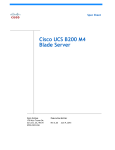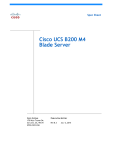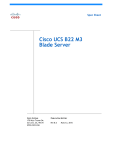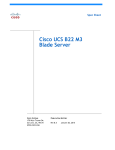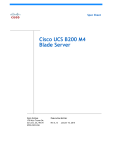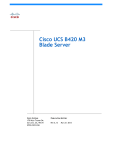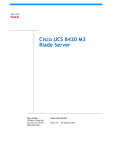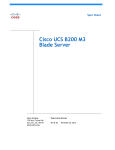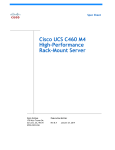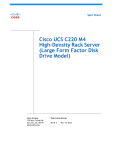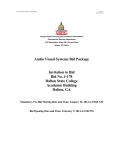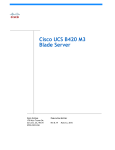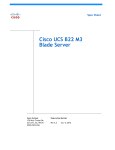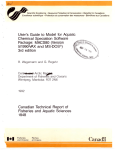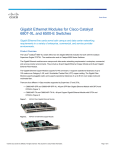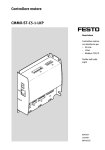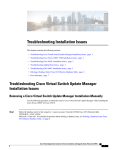Download Cisco 32GB PC4-17000
Transcript
Cisco UCS B420 M4 Blade Server CISCO SYSTEMS 170 WEST TASMAN DR. SAN JOSE, CA, 95134 WWW.CISCO.COM PUBLICATION HISTORY REV A.2 JUNE 17, 2015 CONTENTS OVERVIEW . . . . . . . . . . . . . . . . . . . . . . . . . . . . . . . . . . . . . . . . . . . . . . . 3 DETAILED VIEWS . . . . . . . . . . . . . . . . . . . . . . . . . . . . . . . . . . . . . . . . . . . 4 Blade Server Front View . . . . . . . . . . . . . . . . . . . . . . . . . . . . . . . . . . . . . . . . . . . . . . .4 BASE SERVER STANDARD CAPABILITIES and FEATURES . . . . . . . . . . . . . . . . . 5 CONFIGURING the SERVER . . . . . . . . . . . . . . . . . . . . . . . . . . . . . . . . . . . . 7 STEP STEP STEP STEP STEP STEP STEP STEP STEP STEP STEP STEP STEP 1 VERIFY SERVER SKU . . . . . . . . . . . . . . . . . . . . . . . . . . . . . . . . . . . . . . . . . . . . 8 2 CHOOSE CPU(S) . . . . . . . . . . . . . . . . . . . . . . . . . . . . . . . . . . . . . . . . . . . . . . 9 3 CHOOSE MEMORY . . . . . . . . . . . . . . . . . . . . . . . . . . . . . . . . . . . . . . . . . . . . 11 4 CHOOSE RAID CONTROLLER AND DISK DRIVE BAYS . . . . . . . . . . . . . . . . . . . . . . . 15 5 CHOOSE HARD DISK DRIVES or SOLID-STATE DRIVES (OPTIONAL) . . . . . . . . . . . . . . 18 6 CHOOSE ADAPTERS . . . . . . . . . . . . . . . . . . . . . . . . . . . . . . . . . . . . . . . . . . . 20 7 ORDER A TRUSTED PLATFORM MODULE (OPTIONAL) . . . . . . . . . . . . . . . . . . . . . . 24 8 ORDER CISCO FLEXIBLE FLASH SECURE DIGITAL CARDS . . . . . . . . . . . . . . . . . . . . 25 9 ORDER INTERNAL USB 2.0 DRIVE (OPTIONAL) . . . . . . . . . . . . . . . . . . . . . . . . . . 26 10 CHOOSE OPERATING SYSTEM AND VALUE-ADDED SOFTWARE . . . . . . . . . . . . . . . 27 11 CHOOSE OPERATING SYSTEM MEDIA KIT (OPTIONAL) . . . . . . . . . . . . . . . . . . . . 30 12 CHOOSE SERVICE and SUPPORT LEVEL . . . . . . . . . . . . . . . . . . . . . . . . . . . . . . 31 13 CHOOSE LOCAL KVM I/O CABLE* (OPTIONAL) . . . . . . . . . . . . . . . . . . . . . . . . . 36 SUPPLEMENTAL MATERIAL . . . . . . . . . . . . . . . . . . . . . . . . . . . . . . . . . . . 37 System Board . . . . . . . . . . . . . . . . . . . . . . . . . . . . . . . . . DIMM and CPU Layout . . . . . . . . . . . . . . . . . . . . . . . . . . . . DIMM Population Order . . . . . . . . . . . . . . . . . . . . . . . . . . . Network Connectivity . . . . . . . . . . . . . . . . . . . . . . . . . . . . VIC 1340/1240 and Port Expander . . . . . . . . . . . . . . . . Connectivity Using the Cisco UCS 2208XP Fabric Extender Connectivity using the Cisco UCS 2204XP Fabric Extender . . . . . . . . . . . . . . . . . . . . 37 . . . . . . . . . . . . . . . . . . . . 39 . . . . . . . . . . . . . . . . . . . . 40 . . . . . . . . . . . . . . . . . . . . 44 . . . . . . . . . . . . . . . . . . . . 46 . . . . . . . . . . . . . . . . . . . . 47 . . . . . . . . . . . . . . . . . . . . 53 TECHNICAL SPECIFICATIONS . . . . . . . . . . . . . . . . . . . . . . . . . . . . . . . . . . 58 Dimensions and Weight . . . . . . . . . . . . . . . . . . . . . . . . . . . . . . . . . . . . . . . . . . . . . . . 58 Power Specifications . . . . . . . . . . . . . . . . . . . . . . . . . . . . . . . . . . . . . . . . . . . . . . . . 58 2 Cisco UCS B420 M4 Blade Server OVERVIEW OVERVIEW Designed for demanding virtualization and database workloads, the UCS B420 M4 combines a large memory footprint with four-socket scalability, leveraging the Intel® Xeon® processor E5-4600 v3 product family. The UCS B420 M4 supports 2133 MHz DDR4 memory and utilizes UCS Virtual Interface Card (VIC) technology to achieve up to 160 Gb aggregate I/O bandwidth, all in a dense, full-width blade form factor. The UCS B420 M4 maintains memory performance even as capacity grows, and the large power envelope of the UCS 5108 Blade Server Chassis means the UCS B420 can handle up to 3 TB of memory without compromise to CPU speed or core count. Up to four UCS B420 M4 Blade Servers can be installed in the UCS 5108 Blade Server Chassis. The UCS B420 M4 Blade Server is centrally managed using Cisco UCS Manager. Cisco UCSM provides a single management interface for all hardware and software components of a UCS domain. Cisco UCSM manages up to 160 servers, using Single Connect Technology to consolidate network, storage, and management traffic. With Cisco UCS Central, management can be extended globally to thousands of servers in multiple domains. Figure 1 Cisco UCS B420 M4 Blade Server Cisco UCS B420 M4 Blade Server 3 DETAILED VIEWS DETAILED VIEWS Blade Server Front View Figure 2 is a detailed front view of the Cisco UCS B420 M4 Blade Server. Figure 2 Blade Server Front View 2 3 4 305013 1 14 9 14 5 6 7 8 12 10 11 1 Drive bay 1 8 Power button and LED 2 Drive bay 2 9 Network link status button 3 Drive bay 3 10 Blade health LED 4 Drive bay 4 11 Local console connector1 5 Left blade ejector handle 12 Reset button access 6 Asset pull handle 13 Beaconing LED and button 14 Ejector thumbscrew 13 (a blank asset tag is provided on which you can add your own label or sticker or you can use a marker to write your asset information on the tag) 7 Right blade ejector handle Notes 1. For information about the KVM local I/O cable that plugs into the console connector (a cable is included with every Cisco UCS 5100 Series blade server chassis accessory kit), see CHOOSE LOCAL KVM I/O CABLE* (OPTIONAL) on page 36. 4 Cisco UCS B420 M4 Blade Server BASE SERVER STANDARD CAPABILITIES and FEATURES BASE SERVER STANDARD CAPABILITIES and FEATURES Table 1 lists the capabilities and features of the base server. Details about how to configure the server for a particular feature or capability (for example, number of processors, disk drives, or amount of memory) are provided in CONFIGURING the SERVER on page 7. NOTE: The B420 M4 blade server requires UCS Manager (UCSM) to operate as part of the UCS system. ■ The B420 M4 with E5-4600 v3 CPUs requires UCSM 2.2(5a) or later Table 1 Capabilities and Features Capability/Feature Description Blade server chassis The full-width UCS B420 M4 Blade Server mounts in a Cisco UCS 5100 series blade server chassis CPU Up to four Intel® E5-4600 v3 series processor family CPUs. 2- and 4-CPU configurations are supported on the UCS B420 M4. Chipset Intel® C610 chipset Memory 48 total slots for registered ECC DIMMs I/O 3 configurable adapter slots: Storage controller ■ One slot supports the Cisco VIC 1340/1240 adapter only. ■ Two additional slots support Cisco adapters and Cisco UCS Storage Accelerator adapters. ■ Diskless system (no drive bays or RAID controller), or ■ Optional Cisco FlexStorage 12G SAS RAID controller options, offering: • SAS/SATA/HDD/SSD support • RAID support: 0, 1, 10 Storage devices Either two or four hot-plug 2.5” SFF drive bays One internal USB 2.0 port Two Cisco Flexible Flash secure digital card slots Interfaces Front panel ■ Cisco UCS B420 M4 Blade Server One console connector (see CHOOSE LOCAL KVM I/O CABLE* (OPTIONAL) on page 36) 5 BASE SERVER STANDARD CAPABILITIES and FEATURES Table 1 Capabilities and Features (continued) Capability/Feature Video Description The Cisco Integrated Management Controller (CIMC) provides video using the Matrox G200e video/graphics controller: ■ ■ Integrated 2D graphics core with hardware acceleration DDR2/3 memory interface supports up to 512 MB of addressable memory (8 MB is allocated by default to video memory) ■ Supports display resolutions up to 1920 x 1200 16bpp @ 60Hz ■ High-speed integrated 24-bit RAMDAC ■ Single lane PCI-Express host interface running at Gen 1 speed Power subsystem Integrated in the Cisco UCS 5100 series blade server chassis Fans Integrated in the Cisco UCS 5100 series blade server chassis Integrated management processor The built-in Cisco Integrated Management Controller (CIMC) GUI or CLI interface enables you to monitor the server inventory, health, and system event logs. Cisco UCS Diagnostics for Cisco UCS B-Series Blade Servers The Cisco UCS Blade Server Diagnostics tool for Cisco UCS Blade Servers enables you to verify the health of the hardware components on your servers. The diagnostics tool provides a variety of tests to exercise and stress the various hardware subsystems on the Cisco UCS Blade Servers, such as memory and CPU. You can use the tool to run a sanity check on the state of your Cisco UCS Blade Servers after you fix or replace a hardware component. You can also use this tool to run comprehensive burn-in tests before you deploy a new Cisco UCS Blade Server in your production environment. See the following links for more information: User Guide: http://www.cisco.com/c/en/us/td/docs/unified_computing/ucs/sw/ucs_di agnostics/b_UCS_Blade_Server_Diagnostics_User_Guide.html ISO Download: http://www.cisco.com/cisco/software/navigator.html 6 Cisco UCS B420 M4 Blade Server CONFIGURING the SERVER CONFIGURING the SERVER Follow these steps to configure the Cisco UCS B420 M4 Blade Server: ■ STEP 1 VERIFY SERVER SKU, page 8 ■ STEP 2 CHOOSE CPU(S), page 9 ■ STEP 3 CHOOSE MEMORY, page 11 ■ STEP 5 CHOOSE HARD DISK DRIVES or SOLID-STATE DRIVES (OPTIONAL), page 18 ■ STEP 6 CHOOSE ADAPTERS, page 20 ■ STEP 7 ORDER A TRUSTED PLATFORM MODULE (OPTIONAL), page 24 ■ STEP 8 ORDER CISCO FLEXIBLE FLASH SECURE DIGITAL CARDS, page 25 ■ STEP 9 ORDER INTERNAL USB 2.0 DRIVE (OPTIONAL), page 26 ■ STEP 10 CHOOSE OPERATING SYSTEM AND VALUE-ADDED SOFTWARE, page 27 ■ STEP 11 CHOOSE OPERATING SYSTEM MEDIA KIT (OPTIONAL), page 30 ■ STEP 12 CHOOSE SERVICE and SUPPORT LEVEL, page 31 ■ STEP 13 CHOOSE LOCAL KVM I/O CABLE* (OPTIONAL), page 36 Cisco UCS B420 M4 Blade Server 7 CONFIGURING the SERVER STEP 1 VERIFY SERVER SKU Verify the product ID (PID) of the server as shown in Table 2. Table 2 PID of the Base UCS B420 M4 Blade Server Product ID (PID) UCSB-B420-M4 Description UCS B420 M4 Blade Server with no CPU, memory, HDD, SSD, or adapter cards The base Cisco UCS B420 M4 blade server does not include the following components. They must be selected during product ordering: ■ CPUs ■ Memory ■ Disk drives ■ Cisco adapters (such as the VIC 1340, VIC 1240, VIC 1380, VIC 1280, and Port Expander) ■ Cisco UCS Storage Accelerators NOTE: Use the steps on the following pages to order servers with the configurable components that you want configured in your servers. 8 Cisco UCS B420 M4 Blade Server CONFIGURING the SERVER STEP 2 CHOOSE CPU(S) The standard CPU features are: ■ Intel Xeon processor E5-4600 v3 series processor family CPUs ■ Core counts of up to 18 ■ Cache sizes of up to 45 MB Select CPUs The supported Intel Xeon E5-4600 v3 series CPUs on the UCS B420 M4 are listed in Table 3. Table 3 Supported Intel CPUs: E5-4600 v3 Series Processor Family CPUs Product ID (PID) Intel Number Clock Freq (GHz) Power (W) Cache Cores Size (MB) QPI Highest DDR4 DIMM Clock Support (MHz) Intel Xeon E5-4600 v3 UCS-CPU-E5-4669D E5-4669 v3 2.10 135 45 18 9.6 2133 UCS-CPU-E5-4667D E5-4667 v3 2.00 135 40 16 9.6 2133 UCS-CPU-E5-4660D E5-4660 v3 2.10 120 35 14 9.6 2133 UCS-CPU-E5-4655D E5-4655 v3 2.90 135 30 6 9.6 2133 UCS-CPU-E5-4650D E5-4650 v3 2.10 105 30 12 9.6 2133 UCS-CPU-E5-4640D E5-4640 v3 1.90 105 30 12 8.0 1866 UCS-CPU-E5-4627D E5-4627 v3 2.60 135 25 10 8.0 2133 UCS-CPU-E5-4620D E5-4620 v3 2.00 105 25 10 8.0 1866 UCS-CPU-E5-4610D E5-4610 v3 1.70 105 25 10 6.4 1600 Cisco UCS B420 M4 Blade Server 9 CONFIGURING the SERVER Supported Configurations (1) Two-CPU Configuration ■ Choose two identical CPUs from any one of the rows of Table 3. CPUs 1 and 2 will be populated. (2) Four-CPU Configuration ■ Choose four identical CPUs from any one of the rows of Table 3. ■ The system will run at the lowest CPU or DIMM clock speed. ■ System speed is also dependent on how many DIMMs are populated per channel. ■ For 2-CPU systems, only 24 DIMM slots are functional (channels A - H). ■ See Table 11 on page 22 for supported adapter combinations in 2-CPU systems. ■ For 4-CPU systems, all 48 DIMM slots are functional. Notes 10 Cisco UCS B420 M4 Blade Server CONFIGURING the SERVER STEP 3 CHOOSE MEMORY The standard memory features are: DDR4 ECC registered DIMMs — Clock speed: 2133 MHz — Ranks per DIMM: up to 8 — Operational voltage: 1.2 V Memory is organized with four memory channels per CPU, with up to three DIMMs per channel (DPC), as shown in Figure 3. Bank 2 Bank 3 Bank 1 UCS B420 M4 Memory Organization Bank 3 Figure 3 — E1 E2 E3 A3 A2 A1 Channel A Channel E Channel B Channel F Channel C Channel G Channel D Channel H B3 B2 B1 F1 F2 F3 G1 G2 G3 C3 C2 C1 D3 D2 D1 H1 H2 H3 CPU 2 CPU 3 CPU 4 Channel M Bank 1 Bank 3 Bank 2 Bank 1 CPU 1 I3 I2 I1 Bank 2 Bank 3 ■ DIMMs Bank 2 Bank 1 ■ M1 M2 M3 Channel I J3 J2 J1 N1 N2 N3 Channel J Channel N K3 K2 K1 O1 O2 O3 Channel K Channel O I3 I2 I1 P1 P2 P3 Channel L Channel P 48 DIMMS 4 memory channels per CPU 3 DIMMs per channel Cisco UCS B420 M4 Blade Server 11 CONFIGURING the SERVER Choose DIMMs and Memory Mirroring Select the memory configuration and whether or not you want the memory mirroring option. The supported memory DIMMs and the mirroring option are listed in Table 4. When memory mirroring is enabled, the memory subsystem simultaneously writes identical data to two adjacent channels. If a memory read from one of the channels returns incorrect data due to an uncorrectable memory error, the system automatically retrieves the data from the other channel. A transient or soft error in one channel does not affect the mirrored data, and operation continues unless there is a simultaneous error in exactly the same location on a DIMM and its mirrored DIMM. Memory mirroring reduces the amount of memory available to the operating system by 50% because only one of the two populated channels provides data. Table 4 Supported DDR4 DIMMs and Memory Mirroring Option PID Description Voltage Ranks /DIMM UCS-MR-1X648RU-A 64GB DDR4-2133-MHz TSV-RDIMM/PC4-17000/x4 1.2 V 8 UCS-MR-1X322RU-A 32GB DDR4-2133-MHz RDIMM/PC4-17000/x4 1.2 V 2 UCS-MR-1X162RU-A 16GB DDR4-2133-MHz RDIMM/PC4-17000/x4 1.2 V 2 UCS-MR-1X081RU-A 8GB DDR4-2133-MHz RDIMM/PC4-17000/x4 1.2 V 1 Product ID (PID) DIMM Options Memory Mirroring Option N01-MMIRROR Memory mirroring option Notes ■ ■ 12 DIMM configuration rules: — The minimum configuration is 1 DIMM per CPU — The order in which DIMMs must be installed in a channel is Bank 1 (blue socket), then Bank 2 (black socket), then Bank 3 (white socket). — You cannot mix DIMM capacities within a bank — You can mix DIMM capacities within a channel — 64GB TSV-RDIMMs cannot be mixed with any other DIMMs To optimize memory performance: — Configure DIMMs identically for each CPU — Fill banks equally across the CPU. See DIMM population guidelines in Table 25 on page 40, Table 26 on page 41, and Table 27 on page 41. — Populate less than 3 DPC Cisco UCS B420 M4 Blade Server CONFIGURING the SERVER ■ For systems shipping with E5-4600 v3 series processor family CPUs, DIMM speeds are as shown in Table 5, Table 6, and Table 7 on page 13. Table 5 DIMM Speeds for 2133-MHz E5-4600 v3 Series CPUs DPC DIMM Type 64 GB (TSV) 16/32 GB (DR) 8 GB (SR) 1DPC 2133 2133 2133 2DPC 2133 2133 2133 3 DPC 1600 1866 1600 Table 6 DIMM Speeds for 1866-MHz E5-4600 v3 Series CPUs DPC DIMM Type 64 GB (TSV) 16/32 GB (DR) 8 GB (SR) 1DPC 1866 1866 1866 2DPC 1866 1866 1866 3 DPC 1333 1600 1333 Table 7 DIMM Speeds for 1600-MHz E5-4600 v3 Series CPUs DPC DIMM Type 64 GB (TSV) 16/32 GB (DR) 8 GB (SR) 1DPC 1600 1600 1600 2DPC 1600 1600 1600 3 DPC 1066 1333 1066 For more information regarding memory, see DIMM and CPU Layout on page 39. Cisco UCS B420 M4 Blade Server 13 CONFIGURING the SERVER Supported Configurations (1) Without memory mirroring: ■ Select from 1 to 12 DIMMs per CPU (note that there are 12 DIMM slots per CPU). There must be at least 1 DIMM per CPU. (2) With memory mirroring: ■ 14 Select 4 DIMMs per CPU (installed in bank 1), 8 DIMMs per CPU (installed in banks 1, 2), or 12 DIMMs per CPU (installed in banks 1, 2, 3). Cisco UCS B420 M4 Blade Server CONFIGURING the SERVER STEP 4 CHOOSE RAID CONTROLLER AND DISK DRIVE BAYS The UCS B420 M4 can be ordered with or without the Cisco FlexStorage RAID controller with disk drive bays (local storage subsystem). There is no RAID or local storage controller or drive bays included (embedded) with the B420 M4 server. Therefore, the Cisco FlexStorage RAID controller with drive bays must be purchased in order to support any (1, 2, 3, or 4) local hard disk drives (HDDs) or solid state drives (SSDs). The Cisco FlexStorage RAID controller option includes drive bays one and two, and supports RAID 0,1,10. An optional passthrough module includes drive bays three and four. For servers that do not need any local HDDs or SSDs (for example, for booting from SAN), you can order the server without the Cisco FlexStorage RAID controller with disk drive bays; however be sure to keep Cisco FlexStorage blanking panels installed to maintain proper cooling airflow. The ordering information is listed in Table 10. Table 8 Card Cage and RAID Ordering Options Product ID (PID) PID Description UCSB-MRAID12G Cisco FlexStorage 12G SAS RAID controller with two drive bays UCSB-LSTOR-PT Passthrough module with two drive bays UCSB-LSTOR-BK Cisco FlexStorage blanking panels w/o controller, w/o drive bays See Figure 4 on page 16 for a top view of the B420 M4 server with and without the Cisco FlexStorage SAS RAID controller and drive bays. See Figure 5 on page 16 for a front view of these configurations. When no drive bays are installed, blanking panels must be installed. Cisco UCS B420 M4 Blade Server 15 CONFIGURING the SERVER Figure 4 UCS B420 M4 With and Without Drive Bays (Top View) RAID Controller (integrated in drive bay) Disk Drive Bays (4) Blanking Panels (a) Server with four drive bays Figure 5 (b) Server with no drive bays UCS B420 M4 With and Without Drive Bays (Front View) Blanking Panels (a) Server with four drive bays (b) Server with no drive bays Blanking Panel 16 Cisco UCS B420 M4 Blade Server CONFIGURING the SERVER Supported Configurations1 (1) Four Drive Bays with RAID 0, 1, 10 ■ Choose the following: — One UCSB-MRAID12G. This provides two drive bays installed on the left side of the blade server (viewed from the front). The RAID controller is integrated in the drive bays and provides RAID 0,1,10. — One UCSB-LSTOR-PT. This provides two drive bays installed on the right side of the blade server (viewed from the front) and includes a passthrough connector that allows the drives to be managed from the RAID controller in UCSB-MRAID12G (RAID 0,1,10). (2) Two Drive Bays with RAID 0, 1, 10 ■ Choose the following: — One UCSB-MRAID12G. This provides two drive bays installed on the left side of the blade server (viewed from the front). The RAID controller is integrated in the drive bays and provides RAID 0,1,10. The two right-hand bays are fitted with blanking panels to maintain proper cooling airflow. (3) No Drive Bays ■ System is installed with blanking panels. Notes 1. Any empty drive bays must be fitted with blanking panels to maintain proper cooling airflow. Cisco UCS B420 M4 Blade Server 17 CONFIGURING the SERVER STEP 5 CHOOSE HARD DISK DRIVES or SOLID-STATE DRIVES (OPTIONAL) The UCS B420 M4 can be ordered with or without drives. If you ordered one of the RAID controller with drive bay options in CHOOSE RAID CONTROLLER AND DISK DRIVE BAYS on page 15 (UCSB-MRAID12G for drive bays one and two, and optionally UCSB-LSTOR-PT for drive bays three and four), you can order drives listed in this section. The B420 M4 provides up to four hot plug 2.5” SFF drive bays. Choose Drives The supported drives in the UCS B420 M4 are listed in Table 9. Table 9 Supported Hot Plug Drives PID Description Drive Type Capacity UCS-HD12T10KS2-E 1.2 TB SAS 10K RPM SFF HDD SAS 1.2 TB A03-D600GA2 600 GB SAS 10K RPM SFF HDD SAS 600 GB UCS-HD450G15KS2-E 450 GB SAS 15K RPM SFF HDD SAS 450 GB UCS-HD300G12F105 300 GB 6 Gb SAS 15K RPM SFF HDD SAS 300 GB A03-D300GA2 300 GB SAS 10K RPM SFF HDD SAS 300 GB UCS-SD16T12S2-EP 1.6 TB 2.5 inch Enterprise performance 12G SAS SSD SAS 1.6 TB UCS-SD400G12S2-EP 400 GB 2.5 inch Enterprise performance 12G SAS SSD SAS 400 GB UCS-SD480G0KS2-EV 480 GB 2.5 inch Enterprise Value 6G SATA SSD SATA 480 GB UCS-SD120G0KS2-EV 120 GB 2.5 inch Enterprise Value 6G SATA SSD SATA 120 GB Product ID (PID) HDDs SSDs 18 Cisco UCS B420 M4 Blade Server CONFIGURING the SERVER Supported Configurations ■ Select up to 4 of the drives listed in Table 9. This is dependent on the number of drive bays selected in CHOOSE RAID CONTROLLER AND DISK DRIVE BAYS on page 15. ■ When creating a RAID volume, mixing different capacity drives causes the system to use the lowest-capacity drive. ■ Mixing of drive types is supported, but performance may be impacted. ■ Multiple RAID volumes are supported. RAID volumes should use the same media type. Notes Cisco UCS B420 M4 Blade Server 19 CONFIGURING the SERVER STEP 6 CHOOSE ADAPTERS The adapter offerings are: ■ Cisco Virtual Interface Cards (VICs) Cisco developed 1300 Series and 1200 Series Virtual Interface Cards (VICs) to provide flexibility to create multiple NIC and HBA devices. The VICs also support adapter Fabric Extender and Virtual Machine Fabric Extender technologies. The VIC features are listed here: — 1200 Series VICs enable advanced networking features including Netflow for network statistics, and DPDK, USNIC for low-latency computing applications. — 1300 Series VICs include all of the 1200 Series features plus additional enhancements including network overlay offload support for NVGRE and VXLAN, and RoCE services. — In addition, 1300 Series VICs support PCIe Gen 3.0 for greater bandwidth than 1200 Series VICs — Two Converged Network Adapter (CNA) ports, supporting both Ethernet and FCoE — Delivers 160 Gbs total I/O throughput to the server, for example: • VIC 1240 supports 4 x 10 Gbs Unified I/O ports, Port Expander supports 4 x 10 Gbs Unified I/O ports, and VIC 1280 supports 8 x 10 Gbs Unified ports, for a total of 160 Gbs (see Figure 16 on page 50). • VIC 1340 supports dual 4 x 10 Gbs Unified I/O ports, Port Expander supports 4 x 10 Gbs Unified I/O ports, and VIC 1380 supports 8 x 10 Gbs Unified ports, for a total of 160 Gbs (see Figure 16 on page 50). ■ — Creates up to 256 fully functional unique and independent PCIe adapters and interfaces (NICs or HBAs) without requiring single-root I/O virtualization (SR-IOV) support from operating systems or hypervisors — Provides virtual machine visibility from the physical network and a consistent network operations model for physical and virtual servers — Supports customer requirements for a wide range of operating systems and hypervisors Cisco UCS Storage Accelerator Adapters Cisco UCS Storage Accelerator adapters are designed specifically for the Cisco UCS B-series M4 blade servers and integrate seamlessly to allow improvement in performance and relief of I/O bottlenecks. Table 10 shows the supported adapters. To help ensure that your operating system is compatible with the cards you have selected, please check the Hardware Compatibility List at this URL: http://www.cisco.com/en/US/products/ps10477/prod_technical_reference_list.html 20 Cisco UCS B420 M4 Blade Server CONFIGURING the SERVER Choose an Adapter The supported mezzanine adapters in the UCS B420 M4 are listed in Table 10. Table 10 Supported Mezzanine Adapters Product ID (PID) PID Description Connector Virtual Interface Cards (VICs) UCSB-MLOM-40G-03 Cisco UCS VIC 1340 modular LOM for blade servers Adapter 1 UCSB-VIC-M83-8P Cisco UCS VIC 1380 mezzanine adapter Adapter 3 UCSB-MLOM-40G-01 Cisco UCS VIC 1240 modular LOM for blade servers Adapter 1 UCS-VIC-M82-8P Cisco UCS VIC 1280 mezzanine adapter Adapter 3 Port Expander Card for VIC Option UCSB-MLOM-PT-01 Cisco UCS Port Expander Card for VIC. This is a hardware option to enable an additional 4 ports of the VIC 1340 or VIC 1240, bringing the total capability of the VIC 1340 or VIC 1240 to 8 x 10 GbE Cisco Storage Accelerators1, Adapter 2 2 UCSB-F-FIO-1600MS UCS 1600 GB Fusion ioMemory3 SX Scale line for B-Series Adapter 2 or Adapter 3 UCSB-F-FIO-1300MP UCS 1300 GB Fusion ioMemory3 PX Performance line for B-Series Adapter 2 or Adapter 3 Notes 1. Fusion io storage accelerators must be identical if you choose two of them. 2. As of UCSM version 2.2(4b), the Cisco UCS Storage Accelerators are capable of providing an additional 4 ports of 10 Gb throughput each if placed in adapter slot 2, similar to the Cisco UCS Port Expander Card for VIC. Supported Configurations Table 11 on page 22 and Table 12 on page 23 shows the supported adapter combinations. The configuration rules are summarized as follows: ■ Adapter slot 1 is dedicated for the VIC 1240 or VIC 1340 only. No other mezzanine card can fit in Adapter Slot 1. ■ The Port Expander Card can only be selected if the VIC 1240 or VIC 1340 is also selected for the server. ■ You must select at least one VIC. ■ You can select up to two Storage Acceleration adapters. ■ If using 6100 Series Fabric Interconnects, configure only the VIC 1240/1280 adapters. If using 6200 Series Fabric Interconnects, configure only the VIC 1340/1380 adapters. Cisco UCS B420 M4 Blade Server 21 CONFIGURING the SERVER Select an adapter combination according to Table 11 or Table 12 on page 23. NOTE: CPU1 controls adapter slot 1, CPU 2 controls adapter slot 3, and CPU 4 controls adapter slot 2. Table 11 Supported Adapter Combinations for 4 CPUs Installed Fabric Extenders Aggregate Fabric Bandwidth Interconnects Adapter Configurations Adapter Slot 1 Adapter Slot 2 Adapter Slot 3 2 x 2208XP 2 x 2204XP VIC 1340 not populated not populated 40 Gb/s 20 Gb/s 2 x 62xx VIC 1340 Port Expander Card not populated 80 Gb/s 40 Gb/s 2 x 62xx VIC 1340 not populated VIC 1380 120 Gb/s 60 Gb/s 2 x 62xx VIC 1340 Port Expander Card VIC 1380 160 Gb/s 80 Gb/s 2 x 62xx not populated not populated VIC 1380 80 Gb/s 40 Gb/s 2 x 62xx VIC 1340 Cisco UCS Storage not populated 80 Gb/s 40 Gb/s 2 x 62xx Accelerator (Fusion-io) Note: for the following configuration, slots 2 and 3 must have identical types of storage cards. VIC 1340 Cisco UCS Storage Accelerator (Fusion-io) not populated 80 Gb/s 40 Gb/s 2 x 62xx VIC 1240 Cisco UCS Storage Accelerator (Fusion-io) not populated 40 Gb/s 20 Gb/s 2 x 61xx VIC 1240 not populated VIC 1280 120 Gb/s 60 Gb/s 2 x 61xx VIC 1240 Port Expander Card VIC 1280 160 Gb/s 80 Gb/s 2 x 61xx 22 Cisco UCS B420 M4 Blade Server CONFIGURING the SERVER Table 12 Supported Adapter Combinations for 2 CPUs Installed Fabric Extenders Aggregate Bandwidth Adapter Configurations Adapter Slot 1 Fabric Interconnects Adapter Slot 3 2 x 2208XP 2 x 2204XP VIC 1340 Adapter Slot 21 not populated not populated 40 Gb/s 20 Gb/s 2 x 62xx VIC 1340 Port Expander Card not populated 80 Gb/s 40 Gb/s 2 x 62xx VIC 1340 Port Expander Card VIC 1380 160 Gb/s 80 Gb/s 2 x 62xx VIC 1340 not populated VIC 1380 120 Gb/s 60 Gb/s 2 x 62xx VIC 1340 not populated 40 Gb/s 20 Gb/s 2 x 62xx VIC 1240 not populated Cisco UCS Storage Accelerator (Fusion-io) not populated 40 Gb/s 20 Gb/s 2 x 61xx VIC 1240 not populated VIC 1280 120 Gb/s 60 Gb/s 2 x 61xx Notes 1. Adapter slot 2 is not available except for the Port Expander card. Cisco UCS B420 M4 Blade Server 23 CONFIGURING the SERVER STEP 7 ORDER A TRUSTED PLATFORM MODULE (OPTIONAL) Trusted Platform Module (TPM) is a computer chip (microcontroller) that can securely store artifacts used to authenticate the platform (server). These artifacts can include passwords, certificates, or encryption keys. A TPM can also be used to store platform measurements that help ensure that the platform remains trustworthy. Authentication (ensuring that the platform can prove that it is what it claims to be) and attestation (a process helping to prove that a platform is trustworthy and has not been breached) are necessary steps to ensure safer computing in all environments. The TPM ordering information is listed in Table 13. Table 13 Trusted Platform Module Product ID (PID) PID Description UCSX-TPM2-001 Trusted Platform Module for UCS (SPI-based) NOTE: The module used in this server conforms to TPM v1.2/1.3, as defined by the Trusted Computing Group (TCG). It is also SPI-based. 24 Cisco UCS B420 M4 Blade Server CONFIGURING the SERVER STEP 8 ORDER CISCO FLEXIBLE FLASH SECURE DIGITAL CARDS Dual SDHC flash card sockets are provided on the front left side of the server. Mirroring of two SDHC cards is supported. The SDHC card ordering information is listed in Table 14. Table 14 PIDs for Secure Digital Card(s) Product ID (PID) PID Description UCS-SD-64G-S 64 GB SD Card for UCS servers UCS-SD-32G-S 32 GB SD Card for UCS servers Supported Configurations (1) Select one or two Cisco Flexible Flash secure digital cards ■ Select up to two 32 GB SD cards or two 64 GB SD cards (2) Do not mix 64 GB cards and 32 GB cards Cisco UCS B420 M4 Blade Server 25 CONFIGURING the SERVER STEP 9 ORDER INTERNAL USB 2.0 DRIVE (OPTIONAL) You can order one optional internal USB 2.0 drive. The USB drive ordering information is listed in Table 15. Table 15 26 USB 2.0 Drive Product ID (PID) PID Description UCS-USBFLSHB-16GB UCS Servers 16 GB Flash USB Drive Cisco UCS B420 M4 Blade Server CONFIGURING the SERVER STEP 10 CHOOSE OPERATING SYSTEM AND VALUE-ADDED SOFTWARE Several operating systems and value-added software programs are available. Select as desired from Table 16. Table 16 OSs and Value-Added Software (for 4-CPU servers) PID Description Product ID (PID) Cisco One C1F2PUCSK9 Cisco ONE Foundation Perpetual UCS C1F2SICFBK9 Cisco ONE Foundation Subsr Intercloud Fabric For Business C1A1PUCSK9 Cisco ONE Enterprise Cloud Perpetual UCS C1UCS-OPT-OUT Cisco One Data Center Compute Opt Out Option Microsoft Windows Server MSWS-12-ST2S Windows Server 2012 Standard (2 CPU/2 VMs) MSWS-12-DC2S Windows Server 2012 Datacenter (2 CPU/Unlimited VMs) MSWS-12-ST2S-NS Windows Server 2012 Standard (2 CPU/2 VMs) No Cisco Svc MSWS-12-DC2S-NS Windows Server 2012 Datacenter (2 CPU/Unlim VM) No Cisco Svc MSWS-12R2-ST2S Windows Server 2012 R2 Standard (2 CPU/2 VMs) MSWS-12R2-DC2S Windows Server 2012 R2 Datacenter (2 CPU/Unlimited VMs) MSWS-12R2-ST2S-NS Windows Server 2012 R2 Standard (2 CPU/2 VMs) No Cisco SVC MSWS-12R2-DC2S-NS Windows Server 2012 R2 Datacen (2 CPU/Unlim VM) No Cisco Svc SUSE SLES-2S2V-1A SUSE Linux Enterprise Srvr (1-2 CPU,1 Phys);1yr Support Reqd SLES-2S2V-3A SUSE Linux Enterprise Srvr (1-2 CPU,1 Phys);3yr Support Reqd SLES-2S2V-5A SUSE Linux Enterprise Srvr (1-2 CPU,1 Phys);5yr Support Reqd SLES-2SUV-1A SUSE Linux Enterprise Svr (1-2 CPU,Unl Vrt);1yr Support Reqd SLES-2SUV-3A SUSE Linux Enterprise Svr (1-2 CPU,Unl Vrt);3yr Support Reqd SLES-2SUV-5A SUSE Linux Enterprise Svr (1-2 CPU,Unl Vrt);5yr Support Reqd SLES-2S2V-1A SUSE Linux Enterprise Srvr (4 CPU,1 Phys); 1yr Support Reqd SLES-2S2V-3A SUSE Linux Enterprise Srvr (4 CPU,1 Phys); 3yr Support Reqd SLES-2S2V-5A SUSE Linux Enterprise Srvr (4 CPU,1 Phys); 5yr Support Reqd SLES-2SUV-1A SUSE Linux Enterprise Srvr (4 CPU,Unl Vrt); 1yr Support Reqd SLES-2SUV-3A SUSE Linux Enterprise Srvr (4 CPU,Unl Vrt); 3yr Support Reqd SLES-2SUV-5A SUSE Linux Enterprise Srvr (4 CPU,Unl Vrt); 5yr Support Reqd SLES-2S-HA-1S SUSE Linux High Availability Ext (1-2 CPU); 1yr Support Reqd SLES-2S-HA-3S SUSE Linux High Availability Ext (1-2 CPU); 3yr Support Reqd SLES-2S-HA-5S SUSE Linux High Availability Ext (1-2 CPU); 5yr Support Reqd SLES-2S-GC-1S SUSE Linux GEO Clustering for HA (1-2 CPU); 1yr Support Reqd SLES-2S-GC-3S SUSE Linux GEO Clustering for HA (1-2 CPU); 3yr Support Reqd Cisco UCS B420 M4 Blade Server 27 CONFIGURING the SERVER Table 16 OSs and Value-Added Software (for 4-CPU servers) (continued) PID Description Product ID (PID) SLES-2S-GC-5S SUSE Linux GEO Clustering for HA (1-2 CPU); 5yr Support Reqd SLES-SAP-2S2V-1A SLES for SAP Applications (1-2 CPU,1 Phys); 1yr Support Reqd SLES-SAP-2S2V-3A SLES for SAP Applications (1-2 CPU,1 Phys); 3yr Support Reqd SLES-SAP-2S2V-5A SLES for SAP Applications (1-2 CPU,1 Phys); 5yr Support Reqd SLES-SAP-2SUV-1A SLES for SAP Applications (1-2 CPU,Unl Vrt);1yr Support Reqd SLES-SAP-2SUV-3A SLES for SAP Applications (1-2 CPU,Unl Vrt);3yr Support Reqd SLES-SAP-2SUV-5A SLES for SAP Applications (1-2 CPU,Unl Vrt);5yr Support Reqd Red Hat Enterprise Linux RHEL-2S-1G-1A RHEL/2 Socket/1 Guest/1Yr Svcs Required RHEL-2S-1G-3A RHEL/2 Socket/1 Guest/3Yr Svcs Required RHEL-HA-2S-1A RHEL Option/High-Availability/2 Socket/1Yr Svcs Required RHEL-HA-2S-3A RHEL Option/High-Availability/2 Socket/3Yr Svcs Required RHEL-RS-2S-1A RHEL Option/Resilient Storage w/HA /2 Socket/1 Yr Svcs Reqd RHEL-RS-2S-3A RHEL Option/Resilient Storage w/HA /2 Socket/3 Yr Svcs Reqd RHEL-SFS-2S-1A RHEL Option/Scalable File System/2 Socket/1 Yr Svcs Required RHEL-SFS-2S-3A RHEL Option/Scalable File System/2 Socket/1 Yr Svcs Required Nexus 1000V for Hyper-V and vSphere N1K-VSG-UCS-BUN Over half off N1K and VSG w/ purchase of UCS B/C Series N1K-VLEM-UCS-1 Nexus 1000V License Paper Delivery (1 CPU) for bundles VSG-VLEM-UCS-1 VSG License Paper Delivery (1 CPU) for bundles UCS Director CUIC-PHY-SERV-BM-U Cisco Cloupia Resource Lic - One Phy Server node bare metal CUIC-PHY-SERV-U Cisco Cloupia Resource Lic - One physical Server node CUIC-TERM Acceptance of Cisco Cloupia License Terms UCS Performance Manager UCS-PM-IE UCS Performance Manager UCS-PM-EE UCS Performance Manager Express EVAL-UCS-PM-IE UCS Performance Manager - 60 days evaluation EVAL-UCS-PM-EE UCS Performance Manager Express - 60 days evaluation NFR-UCS-PM-IE UCS Performance Manager - Not For Resale NFR-UCS-PM-EE CS Performance Manager Express - Not For Resale IMC Supervisor EVAL-CIMC-SUP EVAL: IMC Supervisor-Branch Mgt SW for C/E-Series - 50 Svrs EVAL-CIMC-SUP-BAS EVAL: IMC Supervisor One-time Site Installation License CIMC-SUP-B01 IMC Supervisor-Branch Mgt SW for C-Series & E-Series up to 100 Svrs CIMC-SUP-B02 IMC Supervisor- Branch Mgt SW for C-Series & E-Series up to 250 Svrs CIMC-SUP-B10 IMC Supervisor- Branch Mgt SW for C-Series & E-Series up to 1K Svrs 28 Cisco UCS B420 M4 Blade Server CONFIGURING the SERVER Table 16 OSs and Value-Added Software (for 4-CPU servers) (continued) PID Description Product ID (PID) CIMC-SUP-BASE-K9 IMC Supervisor One-time Site Installation License CIMC-SUP-TERM Acceptance of Cisco IMC Supervisor License Terms VMWare 5 VMW-VS5-STD-1A VMware vSphere 5 Standard for 1 Processor, 1 Year, Support Rqd VMW-VS5-STD-2A VMware vSphere 5 Standard for 1 Processor, 2 Year, Support Rqd VMW-VS5-STD-3A VMware vSphere 5 Standard for 1 Processor, 3 Year, Support Rqd VMW-VS5-STD-4A VMware vSphere 5 Standard for 1 Processor, 4 Year, Support Rqd VMW-VS5-STD-5A VMware vSphere 5 Standard for 1 Processor, 5 Year, Support Rqd VMW-VS5-ENT-1A VMware vSphere 5 Enterprise for 1 Processor, 1 Year Support Rqd VMW-VS5-ENT-2A VMware vSphere 5 Enterprise for 1 CPU, 2 Yr Support Rqd VMW-VS5-ENT-3A VMware vSphere 5 Enterprise for 1 CPU, 3 Yr Support Rqd VMW-VS5-ENT-4A VMware vSphere 5 Enterprise for 1 Processor, 4 Year Support Rqd VMW-VS5-ENT-5A VMware vSphere 5 Enterprise for 1 CPU, 5 Yr Support Rqd VMW-VS5-ENTP-1A VMware vSphere 5 Enterprise Plus for 1 Processor, 1 Year Support Rqd VMW-VS5-ENTP-2A VMware vSphere 5 Enterprise Plus for 1 CPU, 2 Yr Support Rqd VMW-VS5-ENTP-3A VMware vSphere 5 Enterprise Plus for 1 Processor, 3 Year Support Rqd VMW-VS5-ENTP-4A VMware vSphere 5 Enterprise Plus for 1 Processor, 4 Year Support Rqd VMW-VC5-STD-1A VMware vCenter 5 Server Standard, 1 yr support required VMW-VC5-STD-2A VMware vCenter 5 Server Standard, 2 yr support required VMW-VC5-STD-3A VMware vCenter 5 Server Standard, 3 yr support required VMW-VC5-STD-4A VMware vCenter 5 Server Standard, 4 yr support required VMW-VC5-STD-5A VMware vCenter 5 Server Standard, 5 yr support required Cisco UCS B420 M4 Blade Server 29 CONFIGURING the SERVER STEP 11 CHOOSE OPERATING SYSTEM MEDIA KIT (OPTIONAL) Choose the optional operating system media listed in Table 17. Table 17 30 OS Media Product ID (PID) PID Description RHEL-6 RHEL 6 Recovery Media Only (Multilingual) SLES-11 SLES 11 media only (multilingual) MSWS-12-ST2S-RM Windows Server 2012 Standard (2 CPU/2 VMs) Recovery Media MSWS-12-DC2S-RM Windows Server 2012 Datacenter (2 CPU/Unlimited VM) Rec Media MSWS-12R2-ST2S-RM Windows Server 2012 R2 Standard (2 CPU/2 VMs) Recovery Media MSWS-12R2-DC2S-RM Windows Server 2012 R2 Datacen(2 CPU/Unlimited VM) Rec Media Cisco UCS B420 M4 Blade Server CONFIGURING the SERVER STEP 12 CHOOSE SERVICE and SUPPORT LEVEL A variety of service options are available, as described in this section. Unified Computing Warranty, No Contract If you have noncritical implementations and choose to have no service contract, the following coverage is supplied: ■ Three-year parts coverage. ■ Next business day (NBD) onsite parts replacement eight hours a day, five days a week. ■ 90-day software warranty on media. ■ Ongoing downloads of BIOS, drivers, and firmware updates. ■ UCSM updates for systems with Unified Computing System Manager. These updates include minor enhancements and bug fixes that are designed to maintain the compliance of UCSM with published specifications, release notes, and industry standards. SMARTnet for UCS For support of the entire Unified Computing System, Cisco offers the Cisco SMARTnet for UCS Service. This service provides expert software and hardware support to help sustain performance and high availability of the unified computing environment. Access to Cisco Technical Assistance Center (TAC) is provided around the clock, from anywhere in the world. For UCS blade servers, there is Smart Call Home, which provides proactive, embedded diagnostics and real-time alerts. For systems that include Unified Computing System Manager, the support service includes downloads of UCSM upgrades. The Cisco SMARTnet for UCS Service includes flexible hardware replacement options, including replacement in as little as two hours. There is also access to Cisco's extensive online technical resources to help maintain optimal efficiency and uptime of the unified computing environment. You can choose a desired service listed in Table 18. Table 18 Cisco SMARTnet for UCS Service Product ID (PID) On Site? Description CON-PREM-B420M4 Yes ONSITE 24X7X2 UCS B420 M4 Blade Server CON-OSP-B420M4 Yes ONSITE 24X7X4 UCS B420 M4 Blade Server CON-OSE-B420M4 Yes ONSITE 8X5X4 UCS B420 M4 Blade Server CON-OS-B420M4 Yes ONSITE 8X5XNBD UCS B420 M4 Blade Server CON-S2P-B420M4 No SMARTNET 24X7X2 UCS B420 M4 Blade Server CON-SNTP-B420M4 No SMARTNET 24X7X4 UCS B420 M4 Blade Server CON-SNTE-B420M4 No SMARTNET 8X5X4 UCS B420 M4 Blade Server CON-SNT-B420M4 No SMARTNET 8X5XNBD UCS B420 M4 Blade Server Cisco UCS B420 M4 Blade Server 31 CONFIGURING the SERVER SMARTnet for UCS Hardware Only Service For faster parts replacement than is provided with the standard Cisco Unified Computing System warranty, Cisco offers the Cisco SMARTnet for UCS Hardware Only Service. You can choose from two levels of advanced onsite parts replacement coverage in as little as four hours. SMARTnet for UCS Hardware Only Service provides remote access any time to Cisco support professionals who can determine if a return materials authorization (RMA) is required. You can choose a service listed in Table 19. Table 19 SMARTnet for UCS Hardware Only Service Product ID (PID) Service Level GSP On Site? Description CON-UCW7-B420M4 UCW7 Yes UC PLUS 24X7X4OS UCS B420 M4 Blade Server CON-UCW5-B420M4 UCW5 Yes UC PLUS 8X5XNBDOS UCS B420 M4 Blade Server Unified Computing Partner Support Service Cisco Partner Support Service (PSS) is a Cisco Collaborative Services service offering that is designed for partners to deliver their own branded support and managed services to enterprise customers. Cisco PSS provides partners with access to Cisco's support infrastructure and assets to help them: ■ Expand their service portfolios to support the most complex network environments ■ Lower delivery costs ■ Deliver services that increase customer loyalty Partner Unified Computing Support Options enable eligible Cisco partners to develop and consistently deliver high-value technical support that capitalizes on Cisco intellectual assets. This helps partners to realize higher margins and expand their practice. PSS is available to all Cisco PSS partners, but requires additional specializations and requirements. For additional information, see the following URL: www.cisco.com/go/partnerucssupport The two Partner Unified Computing Support Options include: ■ Partner Support Service for UCS ■ Partner Support Service for UCS Hardware Only Partner Support Service for UCS provides hardware and software support, including triage support for third party software, backed by Cisco technical resources and level three support. 32 Cisco UCS B420 M4 Blade Server CONFIGURING the SERVER See Table 20. Table 20 Partner Support Service for UCS Product ID (PID) Service Level GSP On Site? Description CON-PSJ1-B420M4 PSJ1 No UCS SUPP PSS 8X5XNBD UCS B420 M4 Blade Server CON-PSJ2-B420M4 PSJ2 No UCS SUPP PSS 8X5X4 UCS B420 M4 Blade Server CON-PSJ3-B420M4 PSJ3 No UCS SUPP PSS 24X7X4 UCS B420 M4 Blade Server CON-PSJ4-B420M4 PSJ4 No UCS SUPP PSS 24X7X2 UCS B420 M4 Blade Server Partner Support Service for UCS Hardware Only provides customers with replacement parts in as little as two hours. See Table 21. Table 21 Partner Support Service for UCS (Hardware Only) Product ID (PID) Service Level GSP On Site? Description CON-PSW2-B420M4 PSW2 No UCS W PL PSS 8X5X4 UCS B420 M4 Blade Server CON-PSW3-B420M4 PSW3 No UCS W PL PSS 24X7X4 UCS B420 M4 Blade Server CON-PSW4-B420M4 PSW4 No UCS W PL PSS 24X7X2 UCS B420 M4 Blade Server Unified Computing Combined Support Service Combined Services makes it easier to purchase and manage required services under one contract. SMARTnet services for UCS help increase the availability of your vital data center infrastructure and realize the most value from your unified computing investment. The more benefits you realize from the Cisco Unified Computing System (Cisco UCS), the more important the technology becomes to your business. These services allow you to: ■ Optimize the uptime, performance, and efficiency of your UCS ■ Protect your vital business applications by rapidly identifying and addressing issues ■ Strengthen in-house expertise through knowledge transfer and mentoring ■ Improve operational efficiency by allowing UCS experts to augment your internal staff resources ■ Enhance business agility by diagnosing potential issues before they affect your operations Cisco UCS B420 M4 Blade Server 33 CONFIGURING the SERVER You can choose a service listed in Table 22. Table 22 UCS Computing Combined Support Service Product ID (PID) Service On Level Description Site? GSP CON-NCF2-B420M4 NCF2 No CMB SPT SVC 24X7X2 UCS B420 M4 Blade Server CON-NCF2P-B420M4 NCF2P Yes CMB SPT SVC 24X7X2OS UCS B420 M4 Blade Server CON-NCF4P-B420M4 NCF4P Yes CMB SPT SVC 24X7X4OS UCS B420 M4 Blade Server CON-NCF4S-B420M4 NCF4S Yes CMB SPT SVC 8X5X4OS UCS B420 M4 Blade Server CON-NCFCS-B420M4 NCFCS Yes CMB SPT SVC 8X5XNBDOS UCS B420 M4 Blade Server CON-NCFE-B420M4 NCFE No CMB SPT SVC 8X5X4 UCS B420 M4 Blade Server CON-NCFP-B420M4 NCFP No CMB SPT SVC 24X7X4 UCS B420 M4 Blade Server CON-NCFT-B420M4 NCFT No CMB SPT SVC 8X5XNBD UCS B420 M4 Blade Server Unified Computing Drive Retention Service With the Cisco Unified Computing Drive Retention (UCDR) Service, you can obtain a new disk drive in exchange for a faulty drive without returning the faulty drive. In exchange for a Cisco replacement drive, you provide a signed Certificate of Destruction (CoD) confirming that the drive has been removed from the system listed, is no longer in service, and has been destroyed. Sophisticated data recovery techniques have made classified, proprietary, and confidential information vulnerable, even on malfunctioning disk drives. The UCDR service enables you to retain your drives and ensures that the sensitive data on those drives is not compromised, which reduces the risk of any potential liabilities. This service also enables you to comply with regulatory, local, and federal requirements. If your company has a need to control confidential, classified, sensitive, or proprietary data, you might want to consider one of the Drive Retention Services listed in Table 23. NOTE: Cisco does not offer a certified drive destruction service as part of this service. 34 Cisco UCS B420 M4 Blade Server CONFIGURING the SERVER Table 23 Drive Retention Service Options Service Description Service Program Name SMARTnet for UCS Service with Drive Retention UCS DR SMARTnet for UCS HW ONLY+Drive Retention UCS HW+DR Service Level GSP Service Level Product ID (PID) UCSD7 24x7x4 Onsite CON-UCSD7-B420M4 UCSD7 8x5xNBD Onsite CON-UCSD5-B420M4 UCWD7 24x7x4 Onsite CON-UCWD7-B420M4 UCWD5 8x5xNBD Onsite CON-UCWD5-B420M4 For more service and support information, see the following URL: http://www.cisco.com/en/US/services/ps2961/ps10312/Unified_Computing_Services_Overview.pdf For a complete listing of available services for Cisco Unified Computing System, see this URL: http://www.cisco.com/en/US/products/ps10312/serv_group_home.html Cisco UCS B420 M4 Blade Server 35 CONFIGURING the SERVER STEP 13 CHOOSE LOCAL KVM I/O CABLE* (OPTIONAL) The local KVM I/O cable ships with every UCS 5100 Series blade chassis accessory kit. The cable provides a connection into the server, providing a DB9 serial connector, a VGA connector for a monitor, and dual USB ports for a keyboard and mouse. With this cable, you can create a direct connection to the operating system and the BIOS running on the server. The local KVM I/O cable ordering information is listed in Table 24. Table 24 Local KVM I/O Cable Product ID (PID) PID Description N20-BKVM= Local KVM I/O cable for UCS servers console port Figure 6 Local KVM I/O Cable 4 2 3 192621 1 1 Connector (to server front panel) 3 VGA connector (for a monitor) 2 DB-9 serial connector 4 Two-port USB connector (for a mouse and keyboard) NOTE: *The blade chassis ships with the local KVM I/O cable. 36 Cisco UCS B420 M4 Blade Server SUPPLEMENTAL MATERIAL SUPPLEMENTAL MATERIAL System Board A top view of the UCS B420 M4 system board is shown in Figure 7. Figure 7 UCS B420 M4 System Board 2 6 3 7 4 1 6 8 9 10 7 5 11 8 6 6 12 3 6 6 7 8 7 1 11 6 6 1 Ejector thumbscrew 7 Heat sink and CPU (underneath) 2 SD card slots 8 CPU heat sink install guide pins 3 Modular storage subsystem connector 9 Trusted Platform Module (TPM) 4 USB memory 10 Adapter 1 slot supports the Cisco VIC 1340/1240 adapter only Cisco UCS B420 M4 Blade Server 305015 8 37 SUPPLEMENTAL MATERIAL 5 6 38 CMOS battery DIMM slots 11 12 Adapter cards: ■ Adapter 2 is the slot on the left (when facing the server) and partially covers Adapter 1 ■ Adapter 3 is the slot on the right (facing the server) Diagnostic button Cisco UCS B420 M4 Blade Server SUPPLEMENTAL MATERIAL DIMM and CPU Layout Memory is organized as shown in Figure 8. Bank 2 Bank 3 Bank 2 Bank 1 Bank 1 UCS B420 M4 Memory Organization E1 E2 E3 A3 A2 A1 Channel A Channel E Channel B Channel F B3 B2 B1 F1 F2 F3 G1 G2 G3 C3 C2 C1 Channel G Channel C D3 D2 D1 H1 H2 H3 Channel H Channel D CPU 2 CPU 3 CPU 4 Channel M Bank 1 Bank 3 Bank 2 Bank 1 CPU 1 I3 I2 I1 Bank 2 Bank 3 Bank 3 Figure 8 M1 M2 M3 Channel I J3 J2 J1 N1 N2 N3 Channel J Channel N K3 K2 K1 O1 O2 O3 Channel K Channel O I3 I2 I1 P1 P2 P3 Channel L Channel P 48 DIMMS 4 memory channels per CPU 3 DIMMs per channel Cisco UCS B420 M4 Blade Server 39 SUPPLEMENTAL MATERIAL Each CPU controls four memory channels and 12 DIMM slots, as follows: CPU1: Channels A, B, C, and D ■ — Bank 1 - A1, B1, C1, and D1 (blue DIMM slots) — Bank 2 - A2, B2, C2, and D2 (black DIMM slots) — Bank 3 - A3, B3, C3, and D3 (white DIMM slots) CPU2: Channels E, F, G, and H ■ — Bank 1 - E1, F1, G1, and H1 (blue DIMM slots) — Bank 2 - E2, F2, G2, and H2 (black DIMM slots) — Bank 3 - E3, F3, G3, and H3 (white DIMM slots) CPU3: Channels I, J, K, and L ■ — Bank 1 - I1, J1, K1, and L1 (blue DIMM slots) — Bank 2 - I2, J2, K2, and L2 (black DIMM slots) — Bank 3 - I3, J3, K3, and L3 (white DIMM slots) CPU4: Channels M, N, O, and P ■ — Bank 1 - M1, N1, O1, and P1 (blue DIMM slots) — Bank 2 - M2, N2, O2, and P2 (black DIMM slots) — Bank 3 - M3, N3, O3, and P3 (white DIMM slots) DIMM Population Order Populate the DIMMs for a CPU according to Table 25. Table 25 DIMMs per CPU Populate CPU 1 Slots Populate CPU 2 Slots Populate CPU 3 Slots Populate CPU 4 Slots 1 A1 E1 I1 M1 2 A1, B1 E1, F1 I1, J1 M1, N1 3 A1, B1, C1 E1, F1, G1 I1, J1, K1 M1, N1, O1 4 A1, B1, C1, D1 E1, F1, G1, H1 I1, J1, K1, L1 M1, N1, O1, P1 5 Not recommended for performance reasons 6 A1, B1, C1, E1, F1, G1, I1, J1, K1, M1, N1, O1, A2, B2, C2 E2, F2, G2 I2, J2, K2 M2, N2, O2 7 40 DIMM Population Order per CPU Not recommended for performance reasons Cisco UCS B420 M4 Blade Server SUPPLEMENTAL MATERIAL Table 25 DIMM Population Order per CPU (continued) DIMMs per CPU Populate CPU 1 Slots Populate CPU 2 Slots Populate CPU 3 Slots Populate CPU 4 Slots 8 A1, B1, C1, D1, E1, F1, G1, H1, I1, J1, K1, L1, M1, N1, O1, P1, A2, B2, C2, D2 E2, F2, G2, H2 I2, J2, K2, L2 M2, N2, O2, P2 A1, B1, C1, E1, F1, G1, I1, J1, K1, M1, N1, O1, A2, B2, C2, E2, F2, G2, I2, J2, K2, M2, N2, O2, A3, B3, C3 E3, F3, G3 I3, J3, K3 M3, N3, O3 9 10 Not recommended for performance reasons 11 Not recommended for performance reasons 12 A1, B1, C1, D1, E1, F1, G1, H1, I1, J1, K1, L1, M1, N1, O1, P1, A2, B2, C2, D2, E2, F2, G2, H2, I2, J2, K2, L2, M2, N2, O2, P2, A3, B3, C3, D3 E3, F3, G3, H3 I3, J3, K3, L3 M3, N3, O3, P3 A quick reference for the recommended DIMM population order is shown in Table 26 and Table 27. CPU 1 DIMM population order is shown as an example. Pick the number of DIMMs in the table you wish to populate, then, starting with A1, populate down Bank 1, then down Bank 2, then down Bank 3 until you reach the number you picked. If you picked 8 DIMMs, for example, use Table 26 and populate DIMMs in A1, B1, C1, D1, A2, B2, C2, and D2. If you picked 6 DIMMs, for example, use Table 27 and populate DIMMs in A1, B1, C1, A2, B2, and C2, leaving D1 and D2 empty. Table 26 DIMM Population Quick Reference for CPU 1 (for 1, 2, 4, 7, 8, 10, 11, or 12 DIMMS) CPU Channel Bank 1 Bank 2 Bank 3 A 1 5 9 B 2 6 101 C 3 71 111 D 4 8 12 Notes 1. Not recommended for performance reasons Table 27 DIMM Population Quick Reference for CPU 1 (for 3, 5, 6, or 9 DIMMS) CPU Channel Bank 1 Bank 2 Bank 3 A 1 4 7 B 2 51 8 C 3 6 9 D empty empty empty Notes 1. Not recommended for performance reasons Cisco UCS B420 M4 Blade Server 41 SUPPLEMENTAL MATERIAL DIMM Physical Layout The overall DIMM and CPU physical layout is shown in Figure 9. Figure 9 DIMM and CPU Layout 1 4 CPU 4 CPU 2 CPU 3 305020 CPU 1 2 3 1 Channel A - D DIMMs for CPU 1 3 Channel I - L DIMMs for CPU 3 2 Channel E - H DIMMs for CPU 2 4 Channels M - P DIMMs for CPU 4 42 Cisco UCS B420 M4 Blade Server SUPPLEMENTAL MATERIAL Figure 10 shows how channels are physically laid out on the blade server. The DIMM slots are contiguous to their associated CPU. Physical Representation of DIMMs and CPUs C1 C2 C3 D1 D2 D3 M1 M2 M3 N1 N2 N3 CPU 1 CPU 4 G1 G2 G3 H1 H2 H3 I1 I2 I3 J1 J2 J3 CPU 2 F3 F2 F1 E3 E2 E1 Cisco UCS B420 M4 Blade Server Rear P3 P2 P1 O3 O2 O1 Front B3 B2 B1 A3 A2 A1 CPU 3 L3 L2 L1 K3 K2 K1 305018 Figure 10 43 SUPPLEMENTAL MATERIAL Network Connectivity This section shows how the supported adapter card configurations for the B420 M4 connect to the Fabric Extender modules in the 5108 blade server chassis. There are three configurable adapter slots on the B420 M4. One slot supports only the VIC 1340/1240 adapter, and two additional slots accommodate Cisco adapters, as well as Cisco UCS Storage Accelerator adapters. Table 11 on page 22 and Table 12 on page 23 show supported adapter configurations. You must install at least one VIC adapter in one of the three adapter slots. Maximum bandwidth is a function of the Fabric Extender, the adapter, and the adapter slot, as shown in Table 28. Table 28 Maximum Bandwidth Using Dual Fabric Extenders (FEXs) FEX Model Maximum Bandwidth Using Dual FEXs 2208XP 160 Gb Example Configuration to Achieve Maximum Bandwidth Adapter 1 = VIC 1340/1240 (4 x 10 Gb) Adapter 2 = Port Expander (4 x 10 Gb) Adapter 3 = VIC 1380/1280 (8 x 10 Gb) See Figure 16 on page 50 2204XP 80 Gb Adapter 1 = VIC 1340/1240 (2 x 10 Gb) Adapter 2 = Port Expander (2 x 10 Gb) Adapter 3 = VIC 1380/1280 (4 x 10 Gb) See Figure 24 on page 55 Figure 11 shows the configuration for maximum bandwidth, where the following ports are routed to 8-port Fabric Extender Modules A and B inside the 5108 blade server chassis: ■ 4 x 10 Gb KR ports from the VIC 1340/1240 adapter ■ 4 x 10 Gb KR ports from the Port Expander ■ 8 x 10 Gb KR ports from the VIC 1380/1280 adapter ■ 4 x 10 Gb from a Cisco Storage Accelerator when placed in adapter slot 2, similar to the Cisco UCS Port Expander Card for VIC. Requires UCSM 2.2(4b) or later. The resulting aggregate bandwidth is 160 Gb (80 Gb to each Fabric Extender). 44 Cisco UCS B420 M4 Blade Server SUPPLEMENTAL MATERIAL Figure 11 UCS B420 M4 Connections to the Fabric Extenders To Fabric Interconnects To Fabric Interconnects UCS 5108 Blade Server Chassis Port Expander or VIC 1380/1280 4 x 10G KR Storage Adapter Accelerator adapter slot #3 adapter slot #2 PCIe x16 CPU 2 PCIe x16 CPU 3 2 x 10G KR 2 x 10G KR 2 x 10G KR Fabric Extender B 2 x 10G KR 4 x 10G KR 4 x 10G KR Fabric Extender A VIC 1340/1240 Adapter Card adapter slot #1 for VIC 1240 PCIe x16 CPU 1 B420 M4 Blade Server Cisco UCS B420 M4 Blade Server 45 SUPPLEMENTAL MATERIAL VIC 1340/1240 and Port Expander Adapter slot 1 is dedicated to the VIC 1340 or VIC 1240 adapter, and no other adapter card can be installed in this slot. There are two groups of four ports on the VIC 1340/1240: ■ Two ports of the first group and two ports of the second group are wired through the UCS 5108 Blade Server chassis to Fabric Extender A and Fabric Extender B. ■ The other two ports of each group are wired to adapter slot 2. The VIC 1340 or 1240 adapter senses the type of adapter installed in adapter slot 2. If a Port Expander is installed in adapter slot 2, the four 10G KR ports between the adapters are used for port expansion; otherwise they are unused. With the Port Expander installed, there are up to eight 10 Gb network interfaces to each Fabric Extender (depending on the Fabric Extender installed), as represented in Figure 12. Figure 12 VIC 1340/1240 Connectivity Fabric Extender B Port Group A 10G KR 10G KR Variable # of ports (depends on Fabric Extender type) 10G KR 10G KR Fabric Extender A Port Group B 10G KR 10G KR Cisco-certified Adapter adapter slot #3 PCIe x16 CPU 2 46 Cisco-certified Adapter adapter slot #2 PCIe x16 CPU 3 10G KR 10G KR VIC 1340/1240 Adapter adapter slot #1 for VIC 1240 PCIe x16 CPU 1 Cisco UCS B420 M4 Blade Server SUPPLEMENTAL MATERIAL Connectivity Using the Cisco UCS 2208XP Fabric Extender The connectivity options shown in Figure 13 on page 48 through Figure 20 on page 52 are summarized in Table 29. Table 29 Supported Adapter Combinations Using the 2208XP FEX1 Adapter Slot 1 Adapter Slot 2 Adapter Slot 3 Total Available Bandwidth 2 x 2208 XP VIC 1340/1240 Not populated Not populated 40 Gb Figure 13 on page 48 VIC 1340 Port Expander Card Not populated 80 Gb Figure 14 on page 48 VIC 1340/1240 Not populated VIC 1380/1280 120 Gb Figure 15 on page 49 VIC 1340/1240 Port Expander Card VIC 1380/1280 160 Gb Figure 16 on page 50 Not populated Not populated VIC 1380 80 Gb Figure 17 on page 50 VIC 1340 Cisco UCS Storage Accelerator Not populated 80 Gb Figure 18 on page 51 VIC 1340 not populated Cisco UCS Storage Accelerator 40 Gb Figure 19 on page 51 VIC 13402 Cisco UCS Storage Accelerator Cisco UCS Storage Accelerator 80 Gb Figure 20 on page 52 Notes 1. Not all combinations are supported in 2-CPU configurations (see Table 11 on page 22) 2. This combination requires that both Storage Accelerators be identical. Cisco UCS B420 M4 Blade Server 47 SUPPLEMENTAL MATERIAL In Figure 13, two ports from the VIC 1340/1240 adapter are channeled to 2208XP Fabric Extender A and two are channeled to 2208XP Fabric Extender B. The result is 20 Gb of bandwidth to each Fabric Extender. Figure 13 VIC 1340/1240 (adapter slots 2 and 3 empty) 2208XP Fabric Extender B Port Group A EMPTY EMPTY No Adapter Installed No Adapter Installed adapter slot #3 adapter slot #2 10G KR 10G KR 10G KR 10G KR 2208XP Fabric Extender A Port Group B VIC 1340/1240 Adapter adapter slot #1 for VIC 1340/1240 PCIe x16 CPU2 CPU 3 CPU 1 In Figure 14, two ports from the VIC 1340 are channeled to 2208XP Fabric Extender A and two are channeled to 2208XP Fabric Extender B. The Port Expander Card installed in adapter slot 2 acts as a pass-through device, channeling two ports to each of the Fabric Extenders. Adapter slot 3 is empty. The result is 40 Gb of bandwidth to each Fabric Extender. Figure 14 VIC 1340 and Port Expander in Adapter Slot 2 (adapter slot 3 empty) 2208XP Fabric Extender B Port Group A adapter slot #3 10G KR 10G KR 10G KR Port Expander Adapter adapter slot #2 PCIe x16 CPU 2 48 Port Group B 10G KR EMPTY No adapter installed 10G KR 10G KR 10G KR 10G KR 10G KR 10G KR 10G KR 10G KR 2208XP Fabric Extender A VIC 1340 Adapter adapter slot #1 for VIC 1340 PCIe x16 CPU 3 CPU 1 Cisco UCS B420 M4 Blade Server SUPPLEMENTAL MATERIAL In Figure 15, two ports from the VIC 1340/1240 are channeled to 2208XP Fabric Extender A and two are channeled to 2208XP Fabric Extender B. Adapter slot 2 is empty. The VIC 1380/1280 installed in adapter slot 3 channels four ports to each of the Fabric Extenders. The result is 60 Gb of bandwidth to each Fabric Extender. Figure 15 VIC 1340/1240 and VIC 1380/1280 (adapter slot 2 empty) 2208XP Fabric Extender B Port Group A Port Group B Port Group A 10G KR 10G KR 10G KR 10G KR 10G KR 10G KR 10G KR 10G KR 10G KR 10G KR 10G KR 10G KR 2208XP Fabric Extender A Port Group B EMPTY VIC 1380/1280 Adapter No Adapter Installed adapter slot #3 adapter slot #2 PCIe x16 CPU 2 Cisco UCS B420 M4 Blade Server PCIe x16 CPU 3 VIC 1380/1240 Adapter adapter slot #1 for VIC 1340/1240 PCIe x16 CPU 1 49 SUPPLEMENTAL MATERIAL In Figure 16, two ports from the VIC 1340/1240 are channeled to 2208XP Fabric Extender A and two are channeled to 2208XP Fabric Extender B. The Port Expander Card installed in adapter slot 2 acts as a pass-through device, channeling two ports to each of the Fabric Extenders. In addition, the VIC 1380/1280 channels four ports to each Fabric Extender. The result is 80 Gb of bandwidth to each Fabric Extender. Figure 16 VIC 1340/1240, Port Expander in Adapter Slot 2, and VIC 1380/1280 in Adapter Slot 3 2208XP Fabric Extender B Port Group A Port Group B 10G KR 10G KR 10G KR 10G KR 10G KR 10G KR 10G KR 10G KR 10G KR 10G KR 10G KR 10G KR 10G KR 10G KR 10G KR 10G KR 2208XP Fabric Extender A Port Group A Port Group B 10G KR 10G KR 10G KR 10G KR VIC 1380/1280 Adapter adapter slot #3 VIC 1340/1240 Adapter Port Expander Adapter adapter slot #2 adapter slot #1 for VIC 1340/1240 PCIe x16 PCIe x16 PCIe x16 CPU 3 CPU 2 CPU 1 In Figure 17, four ports from the VIC 1380 are channeled to 2208XP Fabric Extender A and four are channeled to 2208XP Fabric Extender B. The VIC 1340 slot is empty and adapter slot 2 is empty. The result is 40 Gb of bandwidth to each Fabric Extender. Figure 17 VIC 1380 (VIC 1340 slot empty and adapter slot 2 empty) 2208XP Fabric Extender B Port Group A 10G KR 10G KR 10G KR 10G KR 10G KR 10G KR 10G KR 10G KR 2208XP Fabric Extender A Port Group B EMPTY No adapter installed No VIC 1340 adapter installed adapter slot #3 adapter slot #2 adapter slot #1 for VIC 1340 PCIe x16 CPU 2 50 EMPTY VIC 1380 Adapter PCIe x16 CPU 3 PCIe x16 CPU 1 Cisco UCS B420 M4 Blade Server SUPPLEMENTAL MATERIAL In Figure 18 (supported on 4-CPU configurations), the Storage Accelerator installed in adapter slot 2 acts as a pass-through device, channeling two ports to each of the Fabric Extenders. In addition, two ports from the VIC 1340 adapter are channeled to 2208XP Fabric Extender A and two are channeled to 2208XP Fabric Extender B. The result is 40 Gb of bandwidth to each Fabric Extender. This configuration requires 4 CPUs. Figure 18 VIC 1340 (Cisco UCS Storage Accelerator in slot 2 and adapter slot 3 empty) 2208XP Fabric Extender B Port Group A Port Group B 10G KR EMPTY 10G KR 10G KR No Adapter Installed 10G KR Cisco UCS Storage Accelerator adapter slot #3 10G KR 10G KR 10G KR 10G KR 10G KR 10G KR 10G KR 10G KR 2208XP Fabric Extender A adapter slot #2 VIC 1340 Adapter adapter slot #1 for VIC 1340 PCIe x16 CPU 2 CPU 3 CPU1 In Figure 19 (supported on 2-CPU configurations), two ports from the VIC 1340 adapter are channeled to 2208XP Fabric Extender A and two are channeled to 2208XP Fabric Extender B. The result is 20 Gb of bandwidth to each Fabric Extender. The storage accelerator in slot 3 provides no network connectivity. Figure 19 VIC 1340 (Cisco UCS Storage Accelerator in slot 3 and adapter slot 2 empty) 2208XP Fabric Extender B Port Group A 10G KR 10G KR 10G KR 10G KR 2208XP Fabric Extender A Port Group B EMPTY Cisco UCS Storage Accelerator adapter slot #3 No Adapter Installed adapter slot #2 VIC 1340 Adapter adapter slot #1 for VIC 1340 PCIe x16 CPU 2 Cisco UCS B420 M4 Blade Server CPU 3 CPU1 51 SUPPLEMENTAL MATERIAL In Figure 20, the Storage Accelerator installed in adapter slot 2 acts as a pass-through device, channeling two ports to each of the Fabric Extenders. In addition, two ports from the VIC 1340 adapter are channeled to 2208XP Fabric Extender A and two are channeled to 2208XP Fabric Extender B. The result is 40 Gb of bandwidth to each Fabric Extender. Two identical Cisco UCS Storage Accelerator adapters are installed in slots 2 and 3, but the one in slot 3 provides no network connectivity. This configuration requires 4 CPUs. Figure 20 VIC 1340 (Cisco UCS Storage Accelerator in slots 2 and 3) 2208XP Fabric Extender B Port Group A 10G KR 10G KR 10G KR 10G KR 10G KR 10G KR 10G KR 10G KR 2208XP Fabric Extender A Port Group B 10G KR 10G KR 10G KR 10G KR Cisco UCS Storage Accelerator adapter slot #3 Cisco UCS Storage Accelerator adapter slot #2 VIC 1340 Adapter adapter slot #1 for VIC 1340 PCIe x16 CPU 2 52 CPU 3 CPU1 Cisco UCS B420 M4 Blade Server SUPPLEMENTAL MATERIAL Connectivity using the Cisco UCS 2204XP Fabric Extender The connectivity options shown in Figure 21 on page 54 through Figure 28 on page 57 are shown in Table 30. Table 30 Supported Adapter Combinations Using the 2204XP1 Adapter Slot 1 Adapter Slot 2 Adapter Slot 3 Total Available Bandwidth 2 x 2204 XP VIC 1340/1240 Not populated Not populated 20 Gb Figure 21 on page 54 VIC 1340 Port Expander Card Not populated 40 Gb Figure 22 on page 54 VIC 1340/1240 Not populated VIC 1380/1280 60 Gb Figure 23 on page 55 VIC 1340/1240 Port Expander Card VIC 1380/1280 80 Gb Figure 24 on page 55 Not populated Not populated VIC 1380 40 Gb Figure 25 on page 56 VIC 1340 Cisco UCS Storage Accelerator Not populated 40 Gb Figure 26 on page 56 VIC 1340 not populated Cisco UCS Storage Accelerator 20 Gb Figure 27 on page 57 VIC 1340 Cisco UCS Storage Accelerator2 Cisco UCS Storage Accelerator 40 Gb Figure 28 on page 57 Notes 1. Not all combinations are supported in 2-CPU configurations (see Table 11 on page 22) 2. This combination requires that both Storage Accelerators be identical. Cisco UCS B420 M4 Blade Server 53 SUPPLEMENTAL MATERIAL In Figure 21, one port from the VIC 1340/1240 is channeled to 2204XP Fabric Extender A and one is channeled to 2204XP Fabric Extender B. The result is 10 Gb of bandwidth to each Fabric Extender. Figure 21 VIC 1340/1240 (adapter slots 2 and 3 empty) 2204XP Fabric Extender B 10G KR 10G KR 2204XP Fabric Extender A Port Group A EMPTY EMPTY No Adapter Installed No Adapter Installed adapter slot #3 adapter slot #2 Port Group B VIC 1340/1240 Adapter adapter slot #1 for VIC 1340/1240 PCIe x16 CPU 2 CPU 3 CPU 1 In Figure 22, one port from the VIC 1340 is channeled to 2204XP Fabric Extender A and one is channeled to 2204XP Fabric Extender B. The Port Expander Card installed in adapter slot 2 acts as a pass-through device, channeling one port to each of the Fabric Extenders. Adapter slot 3 is empty. The result is 20 Gb of bandwidth to each Fabric Extender. Figure 22 VIC 1340 and Port Expander in Adapter Slot 2 (adapter slot 3 empty) 2204XP Fabric Extender B 10G KR 10G KR 10G KR 10G KR 2204XP Fabric Extender A Port Group A EMPTY Port Group B 10G KR No adapter installed Port Expander Adapter VIC 1340 Adapter adapter slot #3 adapter slot #2 adapter slot #1 for VIC 1340 10G KR PCIe x16 CPU 2 54 PCIe x16 CPU 3 CPU 1 Cisco UCS B420 M4 Blade Server SUPPLEMENTAL MATERIAL In Figure 23, one port from the VIC 1340/1240 is channeled to 2204XP Fabric Extender A and one is channeled to 2204XP Fabric Extender B. Adapter slot 2 is empty. The VIC 1380/1280 installed in adapter slot 3 channels two ports to each of the Fabric Extenders. The result is 30 Gb of bandwidth to each Fabric Extender. Figure 23 VIC 1340/1240 and VIC 1380/1280 (adapter slot 2 empty) 2204XP Fabric Extender B Port Group A Port Group B 10G KR 10G KR 10G KR 10G KR 10G KR 10G KR 2204XP Fabric Extender A Port Group A Port Group B EMPTY VIC 1380/1280 Adapter No adapter installed VIC 1340/1240 Adapter adapter slot #3 adapter slot #2 adapter slot #1 for VIC 1340/1240 PCIe x16 PCIe x16 CPU 2 PCIe x16 CPU 3 CPU 1 In Figure 24, one port from the VIC 1340/1240 is channeled to 2204XP Fabric Extender A and one is channeled to 2204XP Fabric Extender B. The Port Expander Card installed in adapter slot 2 acts as a pass-through device, channeling one port to each of the Fabric Extenders. In addition, the VIC 1380/1280 channels two ports to each Fabric Extender. The result is 40 Gb of bandwidth to each Fabric Extender. Figure 24 VIC 1340/1240, Port Expander and VIC 1380/1280 2204XP Fabric Extender B Port Group A Port Group B 10G KR 10G KR 10G KR 10G KR 10G KR 10G KR 10G KR 10G KR 2204XP Fabric Extender A Port Group A Port Group B 10G KR 10G KR VIC 1380/1280 Adapter Port Expander Adapter VIC 1340/1240 Adapter adapter slot #3 adapter slot #2 adapter slot #1 for VIC 1340/1240 PCIe x16 PCIe x16 CPU 2 Cisco UCS B420 M4 Blade Server CPU 3 CPU 1 55 SUPPLEMENTAL MATERIAL In Figure 25, two ports from the VIC 1380 are channeled to 2204XP Fabric Extender A and two are channeled to 2204XP Fabric Extender B. The VIC 1340 slot is empty and adapter slot 2 is empty. The result is 20 Gb of bandwidth to each Fabric Extender. Figure 25 VIC 1380 in Adapter Slot 3 (VIC 1340 slot empty and adapter slot 2 empty) 2204XP Fabric Extender B Port Group A 10G KR 10G KR 10G KR 10G KR 2104XP Fabric Extender A Port Group B EMPTY EMPTY VIC 1380 Adapter No adapter installed No VIC 1340 installed adapter slot #3 adapter slot #2 adapter slot #1 for VIC 1340 PCIe x16 PCIe x16 CPU 2 PCIe x16 CPU 3 CPU 1 In Figure 26, the Storage Accelerator installed in adapter slot 2 acts as a pass-through device, channeling one port to each of the Fabric Extenders. In addition, one port from the VIC 1340 is channeled to 2204XP Fabric Extender A and one is channeled to 2204XP Fabric Extender B. The result is 20 Gb of bandwidth to each Fabric Extender. This configuration requires 4 CPUs. Figure 26 VIC 1340 (Cisco UCS Storage Accelerator in slot 2, slot 3 empty) 2204XP Fabric Extender B 10G KR 10G KR 10G KR 10G KR 2204XP Fabric Extender A Port Group A EMPTY 10G KR 10G KR No Adapter Installed Cisco UCS Storage Accelerator adapter slot #3 Port Group B adapter slot #2 VIC 1340 Adapter adapter slot #1 for VIC 1340 PCIe x16 CPU 2 56 CPU 3 CPU 1 Cisco UCS B420 M4 Blade Server SUPPLEMENTAL MATERIAL In Figure 27, one port from the VIC 1340 adapter is connected to 2204XP Fabric Extender A and one is connected to 2204XP Fabric Extender B. The result is 10 Gb of bandwidth to each Fabric Extender. The storage accelerator in slot 3 provides no network connectivity. Figure 27 VIC 1340 (Cisco UCS Storage Accelerator in slot 3 and adapter slot 2 empty) 2204XP Fabric Extender B 10G KR 10G KR 2204XP Fabric Extender A Port Group A Port Group B EMPTY No Adapter Installed Cisco UCS Storage Accelerator adapter slot #3 VIC 1340 Adapter adapter slot #1 for VIC 1340 adapter slot #2 PCIe x16 CPU 2 CPU 3 CPU1 In Figure 28, the Storage Accelerator installed in adapter slot 2 acts as a pass-through device, channeling one port to each of the Fabric Extenders. In addition, one port from the VIC 1340 is channeled to 2204XP Fabric Extender A and one is channeled to 2204XP Fabric Extender B. The result is 20 Gb of bandwidth to each Fabric Extender. Two identical Cisco UCS Storage Accelerator adapters are installed in slots 2 and 3, but the one in slot 3 provides no network connectivity. This configuration requires 4 CPUs. Figure 28 VIC 1340/1240 (Cisco UCS Storage Accelerator in slots 2 and 3) 2204XP Fabric Extender B 10G KR 10G KR 10G KR 10G KR 2204XP Fabric Extender A Port Group A Port Group B 10G KR 10G KR Cisco UCS Storage Accelerator adapter slot #3 Cisco UCS Storage Accelerator adapter slot #2 VIC 1340 Adapter adapter slot #1 for VIC 1340 PCIe x16 CPU 2 Cisco UCS B420 M4 Blade Server CPU 3 CPU 1 57 TECHNICAL SPECIFICATIONS TECHNICAL SPECIFICATIONS Dimensions and Weight Table 31 UCS B420 M4 Dimensions and Weight Parameter Value Height 1.95 in. (50 mm) Width 16.5 in.(419 mm) Depth 24.4 in. (620 mm) Weight ■ Base server weight = 17.780 lb (8.1 kg) ■ Minimally configured server with 2 CPUs, 2 heatsinks, 2 RDIMMs, 1 Mezz, 4 HDD blank) = 21.098 lb (9.57 kg) ■ Minimally configured server with 2 CPUs, 2 heatsinks, 2 LRDIMMs, 1 Mezz, 4 HDD blank) = 21.206 lb (9.62 kg) ■ Fully configured server with 4 CPU, 4 heatsinks, 48 RDIMMs, 3 Mezz, 2 RAID, 4 HDD) = 30.704 lb (13.93 kg) ■ Fully configured server with 4 CPU, 4 heatsinks, 48 LRDIMMs, 3 Mezz, 2 RAID, 4 HDD) = 33.296 lb (15.10 kg) Power Specifications For configuration-specific power specifications, use the Cisco UCS Power Calculator at: http://ucspowercalc.cisco.com 58 Cisco UCS B420 M4 Blade Server


























































